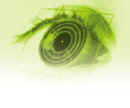
How to capture myopic market share with RGP contact lenses and stress-relieving eyeglasses
By Barbara Anan Kogan, OD
Though there is certainly no single profile of the candidate most likely to purchase RGP contact lenses, here is a look at three markets and what you can do to grow your RGP business within them.

THE STUDENT
Traditionally, children begin to spend many hours reading by the time they're in fourth grade. While many children become first-time myopes around this time, usually in low amounts, others may delay the onset of myopia until junior high or high school.
Right around when Daylight Savings time ends, approximately six weeks into the school year, eye doctors' appointment books become filled with kids. These young people arrive with complaints that chalkboards are blurry and that focusing takes longer when looking far away after close work. They find that concentration on tests becomes more difficult. Their diagnosis most frequently is low to moderate amounts of myopia, usually accompanied by regular or irregular astigmatism.
Still others, unaware of their distance blur, are identified at school vision distance acuity screenings. Rarely are they tested at near, which is where they use the majority of their visual energy. As a result, they become visually stressed. These first-time myopes often have mid-range diopters in their refractions.
Another category is the junior high or high school student who has been wearing soft contact lenses and is experiencing rapidly progressing myopia. This "myopic creep" pace can occur before a six-month or annual evaluation. Their dioptric numbers are commonly in the high range, often double digits.
Astigmatism is prevalent in both vision screening failures and soft contact lens wearers.
Prescribing conventional RGP contact lenses is a viable option to immediately crispen distance viewing. It is also a program to slow down myopia progression, especially that of a rapid nature.
"One of the basic concepts of selecting an RGP material for contact lens fitting is to provide the patient with good, crisp vision," says Carl Moore, RGP committee chair for the Contact Lens Manufacturers Association (CLMA).
While this is especially so for the myope, Moore says that another capability of RGPs is "to relieve all of the visual stress from astigmatism without having any uncorrected astigmatism left over."
He explains it this way to his patients: "If astigmatism is not corrected, it's like looking at a page with the wet newspaper look and having details smudgy and blurry."
The trends in controlling myopia have changed over the years. Back in the 1960s, baby boomers were frequently prescribed PMMA contact lenses. Their yearbooks show them as high school seniors wearing "Coke bottle" eyeglass prescriptions.
Then in the 1980s, it was generally RGP contact lens materials that were prescribed--often to children in middle school. Today's young generation, which matures much earlier, commonly is wearing RGP contact lenses before their teen years.

THE HOBBYIST
The combination of RGPs and spectacle lenses is just as viable for adults. Pleasure reading, especially while multi-tasking with TV viewing, is an activity that can be kept clear effectively, even when moving one's focus to another activity.
The combination can benefit patients involved in any number of activities. For reading at the beach or the swimming pool, for example, UV-coated clip-ons provide an ocular health benefit too. The addition of home projects often require these stress-relieving eyeglasses that should be placed near the hobby site.
Each of these scenarios is age-independent and creates multiple eyeglass purchase opportunities. For example, a reading pair can be kept by the favorite chair or on the night table, and a music pair always can be available on the piano.

THE COMPUTER USER
Electronic reading involves several factors, including:
- Developing accurate visual scanning abilities;
- Looking at words and pictorial images that are constantly in motion;
- Utilizing an extra four inches to eight inches of working distance from the standard 14-inch to 16-inch reading distance;
- And, dealing with the likelihood of after-images with diminished refocusing capabilities from close to far.
A prescription for stress-relieving workstation eyeglasses to be used while wearing RGP contact lenses requires testing of the distance from the eyes to the monitor, keyboard, and hard copy. Lighting and glare data are also helpful, as is pertinent information about image qualities.
For young kids, a workstation prescription is often single vision low plus lenses. For junior and high school students, it is either single vision or bifocals with the distance set at the monitor distance and the segment for the keyboard and desk distance.
College students and on-the-job users often spend four to eight hours per day at the computer workstation. Then, they often spend an additional one to three hours of recreation time at the computer after work. One pair of workstation stress-relieving eyeglasses can be left at the those sites where at least two hours daily are spent viewing a video display terminal.
The real estate philosophy of location, location, location can be applied to the workstation and the close work glasses which accompany RGP wear. This is similar to a presbyope having several pairs of reading glasses at different locations.
All RGP patients should receive instructions about each of the following: workstation set up, good lighting, glare reducing techniques, and the importance of taking visual breaks. As glare is a major complaint from computer users, each pair of workstation glasses should have UV and anti-reflective coatings.
LEVEL OF ALERTNESS
"Because of the way the spectacle lens bends objects, distortions are exacerbated when a myope wears glasses," says Roger Tabb, RGP Lens Institute Advisory Committee member and Beaverton, Ore., optometrist. Tabb notes that he finds those distortions disappear when RGP contact lenses are worn.
"The level of alertness when moving through visual space increases 30 percent to 40 percent." Tabb also notes, "That level can be increased even more with a combination of stress-relieving eyeglass and RGPs, especially when worn during computer use."
With a stress-relieved system, the patient's ability to change focus from near to far and back again is clear and quick. It is also enhanced by the clarity that RGP contact lenses provide.
RGP wearers realize the benefits of their contact lens design and material. It is a custom-designed contact lens that has inhibitory abilities to slow down or reduce myopia progression.
This visually educated patient may opt for an RGP-designed orthokeratology program to reduce or eliminate myopia and astigmatism. If orthokeratology is selected, this patient can still use the stress-relieving eyeglasses for near work.
Tabb compares plus lenses worn by a conventional RGP myopic wearer with a myopia wearer enrolled in an orthokeratology program this way: "An ortho-k lens bends the cornea as it changes its shape, and some of the focusing pressure is negated. When you put a plus eyeglass lens over the RGP contact lens, it relieves the pressure of the cornea and improves focusing."
Whichever kind of program a given patient follows, the patient and his or her family have become loyal to your practice for assisting with stabilizing the progression of myopia. And there's no question that they--and you--will both benefit from RGPs.
| How to Add a Myopia Stress-Reducer Eyeglass Program to Complete a Myopia Control Program |
|
It's a great combination--prescribing low plus eyeglasses, usually of +0.50 or +0.75, to be worn over RGP contact lenses when doing concentrated reading or any close work for 30 minutes or longer. The point is to keep the focusing ability in a visually stress-free mode. This prescription is doctor-determined from a few nearpoint tests that require minimal additional chair time. Roger Tabb, RGP Lens Institute Advisory Committee member and Beaverton, Ore., optometrist, suggests "waiting until a child has gone through puberty prior to putting plus lenses on over RGP contact lenses. This allows for a child to go through natural life-occurring changes and provides more accurate assessment of the stress-relieving eyeglasses." Using flippers, the optician can show the low plus effect to appropriate myopic RGP contact lens wearers. Patients will immediately see how this special prescription makes words bigger and easier to see. Be sure to explain it won't take any extra visual energy. Assisting a child with the appropriate first frames can be combined with prescribing single vision low plus lenses, or flat-top bifocals with plano/low plus. Scratch-guard coating, cleaning, and storage instructions should be included in the wearing instructions of these glasses. This sheet and another on proper lighting, good posture, and taking frequent visual breaks can be distributed to all of the following: patient, parent, babysitter or day care center provider, the PTA, school health nurse, and pediatrician. Benefits of this program, along with your office's name, phone, address, and e-mail should be included on both sheets. The recent passage of the federal program that "No Child Shall Be Left Behind," makes stress-free vision more important than ever for students. That's because annual test taking will become necessary to determine whether a child passes, obtains tutorial help, or repeats a grade. The combination of the RGP contact lenses with the stress-relieving eyeglasses often contributes to the child being a better student, functioning better up close and in the distance, and either not needing a stronger prescription or requiring a minimal change. At the end of the school year, a brief office visit will demonstrate to the student and parent the effectiveness of The Myopia Control and Stress-Reducer Programs. Many children even bring in their report cards and tell you about the grade improvement and how much easier and more fun reading is. For a college-bound myopic patient, the programs become even more important. They will enable a late teenage patient to cope with the increase in the number of up-close hours by creating a visually stress-free environment. Once in college, this myope may also have a part-time job requiring even more close work. |



